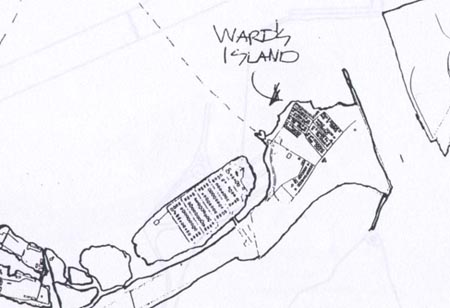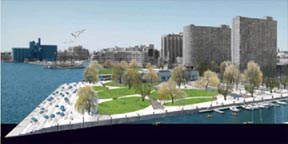In part IV of this series we wrote:
But hey—the Toronto Port Authority operates an airport, too. It used to be called the Toronto Island Airport, but has been rebranded since 1994 as the Toronto City Centre airport. At its peak, in the 1980s, it served some 400,000 passengers annually. Today that number is around 80,000.
That’s a big drop. Does the airport needs another rebranding?
What we forgot to mention is we at the ALLDERBLOB take a stand on branding.
To be precise, we reject it [like “rejecting branding” isn’t a brand? –ed.]. We reject “urbanism” and we reject “disurbanism.”
We like to bike, we will say that. With Ivan Illich we say “Participatory democracy demands low-energy technology, and free people must travel the road to productive social relations at the speed of a bicycle” [can you be any less clear for us? –ed.].
Okay, but given this stance, how is it an outfit that bills itself as “Office for Urbanism” could come calling for us?
Fact is, we contacted them. We heard about the charrette, and offered our services. Our own Jacob Allderdice was accepted as a “local expert” (does this mean we got paid? No).
We were accepted on the strength of a proposal we aired first in 2000 for a waterfront ideas competition run by the Toronto Society of Architects (TSA) [published here and subsequently republished in uTOpia: Toward a New Toronto –ed.]. Our proposal was about as dumb and simple as they get, and for that reason compelling. It was predicated on the fact that thousands of people once lived in the carfree residential communities of Toronto island. Within the living memories of many in Toronto.

A place where everyone got around by bicycle and on foot.
We know people would move there again in a flash because the communities, which operate through a legal anomaly called a land trust, have a waiting list that’s capped at 500 names. There are only some 262 houses on the islands at this time, and no more will be built there without exceptional dispensation.
Is 262 a lot? They say Toronto Island is the largest carfree urban community in North America.
Our TSA competition proposal left the super-hardened concrete runways of the airport as palimpsests, using them to create broad avenues down which a tramline would run, in a loop around the entire site. These avenues would be lined with shops and offices at grade, and four- to five-storeys of apartments over top. Sounds familiar? Think of the best features of any downtown mainstreet.
Except without cars.
Because people don’t shop in cars. Even Jacob Richler gets out of his car to do his shopping.
Then we took the close-knit figure-ground plan of Ward’s Island,

with its 40′ x 50′ lots and its 1200 s.f. houses and its narrow 10-ft lanes, and stamped it around in the interstitial areas between the airport runways. We placed a wide public boardwalk along the western beach, and linked it with the narrow public paths of the Ward’s Island grid, to connect everywhere and anywhere on the Island.

You’d get around on foot, bike or tram only. Like people would, if they could.
The airport’s large existing buildings, the hangars with their lofty spaces and the historically significant control tower, would be adapted for new uses as necessary: a grocery store, a lumber yard, a community centre, etc. And we’d extend the tramline over to the residential communities at the east end of the island, to let them share the new shopping and work opportunities offered by our proposal.

Or they could walk or bike. We figured they’d like that.
But see, that’s where we were wrong. The people who live on the island, at least the ones like Bill Freeman, are among the most vocal opponents of any new places to live being built at the airport site. Freeman’s organization, Community AIR, which was represented in great number at the charrette, is adamant about the airport being replaced with “parkland.” They hold no truck with folks who may want to live in a new carfree setting similar to their own. No, for them the drawbridge is “up.” “Put yourself on the list, like anyone else,” is what Bill Freeman told us when we told him how badly we would like to join his number. Remember, the list is capped.
“Can’t get on the list? Too bad. You’ll have to work on it.”
The man is a walking definition of cynicism.
But he was not the most vocal opponent of new residential uses for the airport.
No, that honor is reserved for the Harbourfront residents and others, like Julie Beddoes, a member of the Gooderham-Worts Distillery neighbourhood. Beddoes is on record decrying gentrification in her own cozy neighbourhood. Maybe her fear for more houses on the island is that with it will come more of the yachting set that lives in the existing part.
But they’re not all like Bill Freeman. We know that.
The Julie Beddoes of the charrette were nonetheless just as adamant as the Bill Freemans that the Island airport site should be a park only. It was as if they could imagine no other building type than their own terrible “harbourfrontal lobotomies” that so desecrate the mainland edge of Toronto.
Of course, if that’s the best Toronto had to offer on the waterfront, we could understand their fears.
But it’s not. We have the example of Ward’s and Algonquin. And we have fine main streets in Toronto too, places we once knew how to build and could be building again.
We participated in the charrette thinking we would have the chance to argue the case for our proposal.
Then we found ourselves in the group facilitated by Janet Rosenberg, landscape architect. Notable for her remarkable waterfront park, “HtO,”

which promises one of the only places along Toronto’s brutal downtown lake edge where a person might dip a toe in the water.
Did we say “argue our case?” Brother, that was no understatement.
Perhaps we were not persuasive enough? Perhaps our logic was insufficient against the fears and cynicism?
Soon, oh readers of the ALLDERBLOB. The truth will out. Janet Rosenberg’s facilitation skills, the Death and Life of the Great American Jane Jacobs, the call to end automobile advertising in all its forms. Soon.